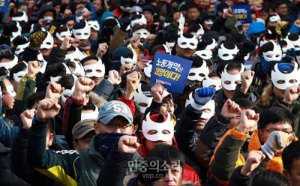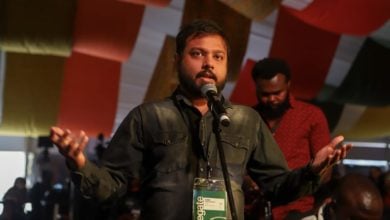Originally published by Labor Notes and Korea Policy Institute.
Massive protests have rocked South Korea’s capital city of Seoul over the past month, as workers demand the ouster of President Park Geun-hye and an end to her plans to make drastic, anti-worker changes to the country’s labor laws.
South Korea has historically been one of the United States’ strongest allies in the region. Its government, like so many others in the age of corporate globalization, is trying to weaken unions and restrict democratic debate.
But there’s a growing resistance—led by organized labor. The Korean Confederation of Trade Unions (KCTU) is anchoring a coalition of workers, farmers, the urban poor, and students to oppose President Park’s pro-corporate agenda and neo-authoritarian rule.
Tens of thousands faced off against the police on November 14, braving high-pressure cannons and tear gas. Undeterred, they marched again on December 5, donning facemasks in defiance of the president’s threats to ban rallies with masks. A 69-year-old farmer remains in critical condition after being doused at short range by a water cannon.
Police have arrested nine members and officials of the Korean Public Service and Transportation Workers Union over the past two weeks, and imprisoned five officials of the Korean Construction Workers Union. In the lead-up to the December 5 demonstration, they raided 12 offices of eight KCTU unions and affiliates, copying files and confiscating documents and computer hard drives.
And police have surrounded a Buddhist temple where KCTU President Han Sang-gyun has been taking sanctuary since November 14 to avoid arrest. If the government doesn’t change course in the coming weeks, Han has called for a general strike.
Four-year temps
Why are South Korean workers so upset? And why is their government responding with such force?
President Park and her ruling New Frontier party want to introduce a package of laws that would fundamentally change the country’s labor market and undermine the power of unions. They would let employers fire workers arbitrarily, increase the use of temporary labor, and extend the contract term for temporary workers from the current two years to four.
“If the reform passes, an employer could hire workers for four years, fire them temporarily, then rehire them for another four years, and they would have no incentive to hire permanent, regular workers,” Han warned in a recent interview.
Contract workers are not entitled to the four major types of insurance that South Korean employers must legally provide to permanent workers—health insurance, unemployment insurance, industrial-accident compensation, and social security. Unions say employers will use this loophole to replace regular workers with contract workers.
Another proposed law would replace the country’s seniority-based salary system with a performance-based system, and let employers terminate workers based on subjective assessments of “low performance.” (Currently, “low performance” cannot be grounds to fire an employee legally, so employers resort to all manners of harassment and humiliation tactics to force employees to leave their jobs voluntarily.)
Also, if companies want to push workers into early retirement, they are legally required to pay them 30 days or more of average wages for each year of consecutive service as severance pay. This new system “would allow a company to get rid of unwanted workers without spending a dime,” Han said.
The new law would also allow employers to change their employment regulations as they please without worker consent. By law, employers of ten workers or more are required to prepare rules of employment, such as payment method of wages and annual paid-leave, etc., and submit them to the Ministry of Labor, as well as post them where workers can have free access to them. A company can alter its employment regulations only with the explicit consent of the labor union, or, if there is no labor union, the majority of its workers.
“This is designed to eliminate all means of resistance by organized labor, and this is precisely the aim of the Park Geun-hye government,” Han said.
The government is also introducing a peak-wage system, in which pay is automatically cut for workers at age 55. The government argues that businesses need to cut the pay of older workers, because they become less productive as they age, and with the money they save, companies can hire more young people and solve the country’s growing youth unemployment. The government is trying to pit the young against the old, but its feigned concern for young people masks the real beneficiaries of the labor reform – companies that stand to reap enormous profits from cutting the wages of older workers and increasing their reliance on temporary labor.
Trouble started in 1997
At the height of its development in the 1980s, South Korea’s economy was highly export-driven and controlled by a handful of family-owned conglomerates, such as Hyundai and Samsung. Workers at large industrial plants produced steel, automobiles, electronic parts, and textiles for export.
Once a worker was hired by one of these companies, he or she was considered to have a job for life. A worker generally devoted his or her entire career to one company and had an opportunity to climb the ladder, with salaries based on seniority.
The movement for democracy against the military dictatorship during the 1970s and 1980s produced a strong, militant labor movement, based in large industrial unions. At its height in 1996, for example, three million workers shut down auto and ship production, and disrupted hospitals, subways and television broadcast for 4 weeks to oppose newly passed labor laws that would give employers more power to lay off workers.
That all changed after the Asian financial crisis in 1997. Foreign investors bought up shares in South Korean companies at bargain prices. The International Monetary Fund (IMF) bailed out South Korea’s economy—but at a steep price.
It introduced two laws that devastated worker standards. One legalized layoffs for the first time in South Korea, and another legalized the use of dispatch workers through employment agencies and popularized the practice of in-house subcontracting.
Almost overnight, workers with decent, well-paying, secure jobs became “precarious workers”—part-timers or temps without benefits or job security. Today, among Organisation for Economic Cooperation and Development (OECD) countries, South Korea ranks number one for the most precarious workforce.
Now the government wants to make workers even more precarious—and is intent on passing its controversial reform before the year is over.
Labor-led united front
Park, the daughter of a former military dictator, has come under widespread criticism for introducing neo-authoritarian practices that hark back to her father’s era.
For instance, since taking power, she has used the outdated National Security Law to jail an opposition lawmaker and dissolve an opposition party, and has outlawed the Korean Government Employees’ Union and the left-leaning Korean Teachers and Education Workers Union. Now she wants to replace all history textbooks in public schools with a single, government-authored history text.
The recent protests are part of a coalition effort. Fifty-two organizations representing various sectors of society came together earlier this year to establish a national coordinating body, with regional chapters across the country.
They’re united not only against the labor law changes, but also the rest of Park’s pro-corporate agenda and anti-democratic initiatives. Farmers are especially opposed to the series of free trade agreements that her government is pursuing—including the Trans-Pacific Partnership, which will further undermine the domestic rice market with a flood of cheap imports and weaken the country’s ability to feed itself.
KCTU, the coalition’s anchor, is the second largest labor federation in South Korea and by far the most militant. With 626,035 members, it accounts for approximately 40 percent of trade union members in South Korea and has more than 1,200 affiliated enterprise-level trade unions.
The larger and historically more pro-government Federation of Korean Trade Unions (FKTU) had pledged earlier this year to not participate in the tripartite negotiations with government and business representatives about the changes to the labor laws. But its leadership did an about-face in the fall of this year and entered the talks, giving legitimacy to the government’s push for anti-worker changes to the Labor Standards Acts and other labor laws. Rank and file members of FKTU, especially those in the financial, metal, and public sectors, strongly oppose their leadership’s compromise with the government.
KCTU President Han, who boycotted the tripartite committee, considered by many as a rubber-stamping institution, is no stranger to struggle. In 2009, as head of the Ssangyong Motor branch of the Korean Metal Workers Union, he led 900 workers in a 77-day occupation of a SsangYong Motor plant to protest mass layoffs (their slogan: “Layoffs equal murder”), and this earned him a three-year jail sentence.
After he was released from prison, he launched a new protest—occupying an electrical transmission tower, 164 feet in the air, for 171 days, making the SsangYong layoffs a major issue in the 2012 presidential elections.
In 2014 he became KCTU president in the labor federation’s first direct election in which all 600,000 members were eligible to vote.
He ran on a pledge, if elected, to launch a general strike and make KCTU into Park’s “greatest fear.”
Hyun Lee and Gregory Elich are both members of US-Korea Solidarity Committee for Democracy and Peace. Gregory Elich is also the co-author of Killing Democracy: CIA and Pentagon Operations in the Post-Soviet Period. Lee is a KPI fellow and Elich is on the KPI Advisory Board.







